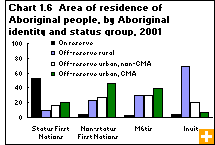Common menu bar links
Where do Aboriginal people live?
Archived Content
Information identified as archived is provided for reference, research or recordkeeping purposes. It is not subject to the Government of Canada Web Standards and has not been altered or updated since it was archived. Please contact us to request a format other than those available.
According to the 2001 Census, 70% of 976,305 people with Aboriginal identity lived off reserves. Indian reserves are lands set aside for First Nations people, also referred to as North American Indians. In 2001, more than half (53%) of 505,000 First Nations people with legal Indian status lived on reserves. Because reserves are set aside for First Nations people, very few Métis or Inuit live on reserve lands.
In 2001, only 7,315 Métis—3% of Canada’s 292,310 Métis—lived on reserves. Nearly 7 in 10 lived in cities: 4 in 10 in large cities, 3 in 10 in smaller cities.
The Inuit live predominantly in the North. In 2001, about half of Canada’s 45,070 Inuit population was living in Nunavut, 21% in Nunavik (Northern Quebec), 10% in Nunatsiavut (Labrador) and 9% in Inuvialuit (Northwest Territories). With just 7% in large urban centres, the Inuit are the least likely of all Aboriginal people to live in large urban centres.
Among the 48% of First Nations peoples with legal Indian status who lived off reserves in 2001, most were in urban areas (21% in large cities and 17% in small cities), while the remaining 10% lived in rural non-reserve areas. Of First Nations peoples without legal Indian status, 73% lived in cities (both large and small).
Contrary to popular belief, Indian reserves are not losing population. Over the last 20 years, reserves have experienced small net gains in population with 3% of their population moving away, but 4% moving to reserves.



